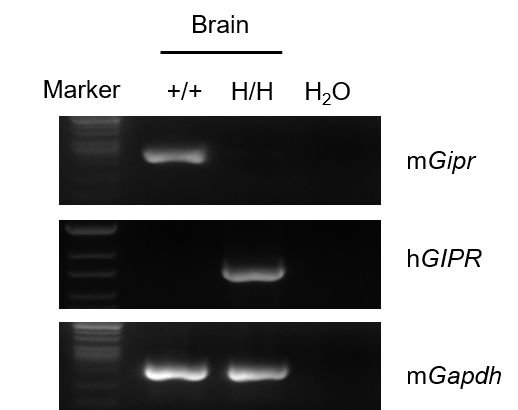Description
- GIPR, gastric Inhibitory polypeptide receptor, belongs to the G-protein coupled receptor family. GIPR is expressed in many tissues including pancreas, stomach, brain, liver, etc. This protein plays a crucial role in regulating insulin secretion, glucose and lipid metabolism. Mutations or changes within this gene have been associated with various health conditions including obesity and diabetes.
- The glucagon-like peptide-1 receptor (GLP1R) is a receptor protein found on beta cells of the pancreas and on neurons of the brain. It is involved in the control of blood sugar levels by enhancing insulin secretion.
- B-hGIPR/hGLP1R mice were obtained by mating B-hGIPR mice (112714), and B-hGLP1R mice (170164). For validation data of this mouse model, you can refer to the validation data from the related gene humanized mouse models.
- Gene targeting strategy for B-hGIPR mice. The full coding region sequences of the mouse Gipr gene were replaced by human GIPR CDS + 3’UTR in B-hGIPR mice. As a result, mouse Gipr sequences will be deleted, and only human GIPR will be expressed in B-hGIPR mice.
- Gene targeting strategy for B-hGLP1R mice. The full coding sequence of the human GLP1R gene was inserted into the mouse Glp1r gene exon 1 in B-hGLP1R mice. The human GLP1R protein expression will be driven by the endogenous mouse Glp1r promoter, while mouse Glp1r gene transcription and translation will be disrupted.
Targeting strategy
B-hGIPR/hGLP1R mice were obtained by mating B-hGIPR mice (112714), and B-hGLP1R mice (170164). For validation data of this mouse model, you can refer to the validation data from the related gene humanized mouse models.
- Gene targeting strategy for B-hGIPR mice. The full coding region sequences of the mouse Gipr gene were replaced by human GIPR CDS + 3’UTR in B-hGIPR mice. As a result, mouse Gipr sequences will be deleted, and only human GIPR will be expressed in B-hGIPR mice.
- Gene targeting strategy for B-hGLP1R mice. The full coding sequence of the human GLP1R gene was inserted into the mouse Glp1r gene exon 1 in B-hGLP1R mice. The human GLP1R protein expression will be driven by the endogenous mouse Glp1r promoter, while mouse Glp1r gene transcription and translation will be disrupted.
mRNA Expression Analysis
Strain specific analysis of GIPR mRNA expression in wild-type C57BL/6JNifc mice and B-hGIPR/hGLP1R mice by RT-PCR. Brain RNA was isolated from wild-type C57BL/6JNifc mice (+/+) and homozygous and B-hGIPR/hGLP1R mice (H/H, H/H), then cDNA libraries were synthesized by reverse transcription, followed by PCR with mouse or human GIPR primers. Mouse Gipr mRNA was detectable only in wild-type C57BL/6JNifc mice but not in homozygous B-hGIPR/hGLP1R. Human GIPR mRNA was detectable only in homozygous and B-hGIPR/hGLP1R mice but not in wild-type mice.
Human GLP1R Protein Expression Analysis in B-hGIPR/GLP1R mice
Human GLP1R expression in different tissues of B-hGIPR/GLP1R mice by IHC. Tissues were stained with human-specific antibodies GLP1R (Abcam, ab254352). The brain, pancreas, lung, stomach, and large intestine of B-hGIPR/hGLP1R mice show human GLP1R negative (A, B, C, E, F). Liver, kidney, and adipose tissue of B-hGIPR/hGLP1R mice show human GLP1R negative. Original magnification ×200. Abbreviations: IHC, immunohistochemistry.
* When publishing results obtained using this animal model, please acknowledge the source as follows: The animal model [B-hGIPR/hGLP1R mice] (Cat# 113536) was purchased from Biocytogen.


